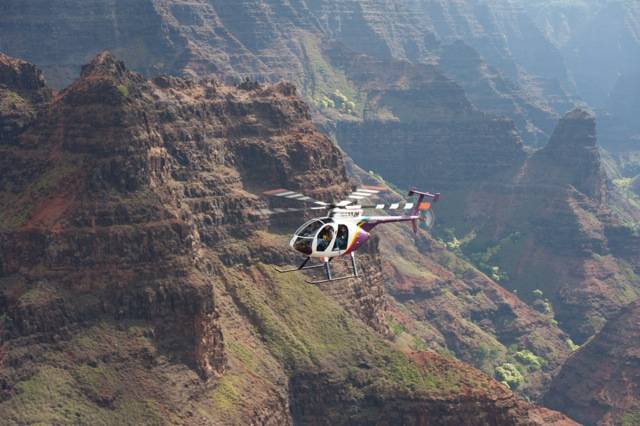HONOLULU — With sightseers hoping to get a bird’s-eye view of flowing lava, Hawaii Volcanoes National Park in 2018 was the most popular site in the country for commercial air tours of national parks.
More than 8,300 flyovers of the Big Island attraction were reported that year, topping the National Parks of New York Harbor, the second most popular site, according to federal data.
And even though lava from Kilauea Volcano has since stopped flowing, the helicopter trips over HVNP continue on a daily basis, weather permitting.
Mike Linnolt, who lives in Volcano just outside the park, is frustrated by all the air traffic. He said the flights typically number dozens each day, appearing overheard as early as 7:15 a.m. and continuing into the late afternoon. The aircraft get close enough that he can sometimes see the faces of the passengers.
“It comes in waves,” he lamented, “one after another.”
The helicopter noise disrupts conversations on the ground and disturbs what otherwise would be a tranquil mountain environment. Some aircraft are so close as they whiz by that the windows on Linnolt’s home shake.
“It’s pretty disruptive,” said the Hawaii Pacific University adjunct professor of natural sciences. “This used to be a very quiet place.”
Linnolt is among a growing number of people calling for tougher restrictions on Hawaii’s tour helicopter and small aircraft industry, particularly as the volume of traffic has increased in recent years over residential communities, national parks and other areas.
The flights not only cause noise disruptions but present potential dangers to those on the ground, Linnolt and others say.
The calls for tougher oversight have intensified in the wake of three fatal air crashes in Hawaii that killed 21 people in the past eight months. The most recent tragedy claimed the lives of six visitors and a pilot when their sightseeing helicopter crashed Dec. 26 on Kauai.
On April 29, three people died when their tour helicopter plummeted to the ground in a Kailua neighborhood, barely missing homes. No one on the ground was hurt.
On June 21, 11 people perished when their skydiving plane crashed on takeoff on the North Shore.
In the wake of the crashes, the City Council and more than half of the Oahu neighborhood boards have passed resolutions expressing alarm about the increasing air traffic over residential communities. The resolutions urge the Federal Aviation Administration to adopt stricter regulations.
“It’s a public safety issue, plain and simple,” said Richard Figliuzzi, chairman of the Diamond Head/Kapahulu/St. Louis Heights Neighborhood Board, one of the panels calling for action.
U.S. Rep. Ed Case in September introduced legislation requiring increased federal restrictions nationally on tour helicopter and small aircraft operations. The Safe and Quiet Skies Act, which is pending in the House, also would allow local and state agencies to adopt additional regulations tailored to their communities.
Following last week’s crash, Case criticized the industry, saying it is unsafe, incapable of self-regulation and has ignored sensible safety improvements in Hawaii.
He also criticized the FAA, saying the agency has not taken seriously recommendations made by the National Transportation Safety Board in the wake of multiple crashes. The NTSB has placed safety improvements for the industry on its highest priority list, according to Case.
Asked for comment on the congressman’s criticisms, an FAA spokesman issued a general statement.
“Safety is the FAA’s top priority, and the FAA’s air tour regulations include requirements that are specific to Hawaii operations,” the spokesman said in an email. “The agency conducts random and regular surveillance on all Hawaii air tour operators, and ensures companies address any issues we may find. While we are always looking for possible trends, we have not identified issues of concern that are applicable to the industry statewide.”
Melissa Pavlicek, executive director of the Hawaii Helicopter Association, said her organization is working with a task force that includes the FAA and state transportation officials to address concerns raised by the neighborhood boards, the City Council and others.
“We’ve been working hard to cooperate and be collaborative with this working group,” Pavlicek told the Star-Advertiser in an interview. “We’re hoping there will be good outcomes from it.”
While she noted there are several points in Case’s proposed legislation the industry agrees with, the bill also “introduces inflexibility into the regulations which is counter to the needs for adaptive responses to changing weather, geographic, equipment and air traffic control conditions,” Pavlicek added in a statement. “We do not yet know whether any of these were factors in the Kauai accident and we are monitoring the developments of the NTSB investigation. No accident is ever acceptable and the industry strives to perform safely every day.”
Trend data from the state Department of Transportation, which oversees Hawaii airports, indicate that helicopter tours statewide have increased dramatically in recent years.
Landings involving helicopters with 17 tour companies at Hawaii airports totaled 8, 246 in March, up 67 % from the roughly 4, 900 landings reported in the same month in 2010, according to DOT statistics.
The 2,105 landings at the Daniel K. Inouye International Airport on Oahu in March were about nine times the level from the same month in 2010.
The statistics were compiled in July by the Transportation Department, responding to a request from state Sen. Laura Thielen. The Windward Oahu senator has been working with Case’s office to get more data and other information about the industry.
Thielen said complaints about the noise and dangers associated with air tours have increased. “Every year it’s been getting more and more,” she added.
And it’s not just residents voicing concerns.
The state DOT asked Case to designate Hawaii’s commercial harbors as restricted airspace for sightseeing helicopters and small aircraft under his proposed Safe and Quiet Skies Act. Such a move would minimize acts of terror and eliminate accidents, according to a September letter from DOT Director Jade Butay to Case.
“In the past helicopters have entered Hawaii’s commercial harbors and have been seen flying lower than gantry cranes, masts of a cruise ship and even the Aloha Tower,” Butay wrote.
The Navy likewise has expressed safety and security concerns about tour helicopters and small aircraft flying over Pearl Harbor, according to Case.
And managers of the Pearl Harbor National Memorial, along with veterans, visitors and community groups, have voiced “constant and increasing concerns” about the helicopter flyovers “destroying the solemnity and sanctity of the memorial,” Case wrote in a Dec. 24 letter updating his efforts to push for increased oversight of the industry.
Case said in the letter that he asked the FAA to prohibit tour helicopters and small aircraft from flying over Hawaii harbors and is awaiting a response.
He also is awaiting an answer to his request that alternate routes to and from the Honolulu airport be reviewed.
The FAA currently requires tour helicopters and small aircraft to fly into and out of the airport at very low altitudes “directly over residential neighborhoods and other sensitive areas” even though ocean routes are available, according to his letter.
As of last month, 19 Oahu neighborhood boards, including the Waialae-Kahala one, had approved resolutions urging the federal government to impose more effective regulations of the aircraft.
“They’re constantly flying over us,” said Rich Turbin, chairman of the Waialae-Kahala board, citing the noise issue and potential crash dangers. “It’s a hideous problem.”
Linnolt, the Volcano resident, said the problem has become much worse the past several years. He remembers moving from Kaimuki to Volcano with his wife, Rie Linnolt, and their two children a decade ago when helicopter flyovers of the Big Island town were infrequent.
Not any more.
“Now I keep telling people we had a much quieter life in Honolulu,” Linnolt said.


